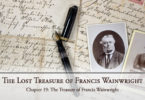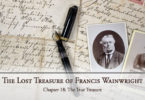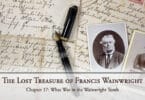Christine put the ancient key in the old, rusty lock, as her cousins and the old lady from the town hall stood around her. At first, the key did not want to turn, and they all wondered if the centuries, along with corrosion and rust and dust and who knew what else, were conspiring to keep them from entering the Wainwright family tomb. They all kind of wished that were true… as much as they wanted to find the statue (which may be the treasure), there were plenty of things that could be in that tomb that they didn’t want to find. It was a real coin toss on their actual desire to go in there, but they promised each other, and their grandmother, to see this through. They had to at least try and give it a genuine try, not a half-hearted one.
After some encouragement from her cousins, Christine kept pushing on the key, and it finally moved after a few more twists and turns. It didn’t go all the way around at first… that took more pushing… but as old debris fell away from the tumblers inside the lock, the key did move more and more, until finally, it went all the way around. An audible “click” was heard by all. Christine put her fingernails in the narrow space between the door and the side of the hill, where a rudimentary wooden frame for the door was set up, dug in, and pulled.
The large, metal door moved, but just an inch. It was enough.
James and Adam took over, and between the two of them, they were able to get their fingers around the side of the door just enough to give them the leverage they needed to open it. Little bits of flaked rust, dirt from the hill around the tomb, dust from the centuries, cobwebs, and tiny particles of unknown material no one wanted to think about floated away from the wooden door frame and to the ground. James and Adam stepped back until the way was clear, holding out their arms so the women didn’t go past them, as they wanted to avoid contact with anything unclean if they could avoid it.
Once the door was open, they all looked into a cavern of darkness. That meant it had to be deep, doing farther into the hill than they imagined. Otherwise, the light coming in through the open doorway would have illuminated something. Obviously, whatever was in there was well beyond the door. They were going to have to go all the way inside.
“Phone flashlights on?” Emily suggested.
They all did as she asked. No sense in going in if they wouldn’t be able to see anything clearly in the darkness.
The old woman from the town hall offered to wait outside, and they were grateful for a lookout, in case muggers or other evildoers came along. Still, Christine kept a firm grip on the key. The situation was creepy as it was. She didn’t want to have the extra concern of a relative stranger locking them in to contend with (even if their phones were likely to get reception so close to the outside world and offer them safety in such an event).
About eight feet into the tomb, they came across a granite sarcophagus, with the effigy of a man on it, and the name “Francis Wainwright” inscribed, along with some dates, Bible verses, and poetry. About two feet across from Francis’s sarcophagus was a similar one, only with the effigy of a woman on it. It had similar inscriptions to Francis’s, except the name on the top was “Philippa Wainwright.”
They’d found their ancestors. What else would they discover?
“At least they weren’t out in the open,” Grace said softly, almost reverently. This was a sacred space, after all.
“Thank goodness,” Emily added. It was the biggest unspoken concern they all had about this part of the adventure. No one wanted to come across shrouded skeletons laying on top of granite or marble slabs like you often saw in tomb scenes in Shakespearean productions.
“Hello, Francis and Philippa,” James whispered. The other cousins did the same.
They walked farther back into the tomb, and came across two more sarcophagi, of one of Francis’s son and his wife, as well as a series of about a dozen and a half medium-sized headstones, indicating members of the Wainwright family who had actually been buried inside the tomb, beneath it’s rough marble floor, over a period of about a century and a half, right up to the time Philippa’s statue disappeared from the cemetery maps, in fact.
In the very back of the tomb, far away from any outside light, right next to the rough rock and dirt wall that was actually part of the inside of the hill, but just shy of touching it, was the statue.
Not merely life-sized, but about twice the height Philippa would have had in life, still, as golden as the day it was sculpted, it stood, looking over the hidden graves of Philippa’s husband, children, grandchildren, and great-grandchildren like a sentry. A sentry with the barest hint of a warm smile on its face. This was a woman who loved her duty of guarding over her family, and she loved the people within this tomb. No wonder the Wainwrights of the American Revolution wanted to protect her.
The statue was attached to a circular base of polished stone. Carved into the stone was her full name: “Philippa Sewell Wainwright.” Underneath the name was another inscription in large, elegant print that had a Latin look to it, though the words were in colonial English.
“Beloved wife of Francis. Devoted mother to her children. Journeyer from England to across the sea. Respected citizen of Ipswich. Child of God. Never to be forgotten. This statue is here placed so the world may always remember her, as we her family do.”
It was beautiful.
They were all quiet for a moment, admiring the tribute Francis had created for his cherished wife. The love story of their ancestors was the stuff of legend. And, legend it was because it gave birth to the story of the treasure.
Grace was the first to voice out loud what they were all wondering. “Is this the treasure?” she asked. “If it is, it is certainly treasure enough. Who else has something like this in their family, unless they’re descended from someone famous to the world? It’s a wonderful treasure on its own. But, is there something more to it?”





